Review and Photos by Dr Andre Mursch (“Brontodocus”). Edited by Plesiosauria.
Although it was rather uncommon and a good deal smaller than contemporaneous Allosaurus, Ceratosaurus nasicornis is arguably one of the most famous theropod dinosaurs. At its time it was a rather primitive theropod with a four-fingered hand, a deep and heavy tail and a less athletic chest than more advanced theropods had. Ceratosaurus is more recognizable than most other theropods due to some unique characteristics. The large, laterally flattened, nasal horn, the mid-dorsal row of osteoderms, the very deep tail and the peculiarly large upper jaw’s teeth that – at least in juveniles – could even protrude beyond the dentary’s lower margin make Ceratosaurus a truly bizarre, unique theropod.
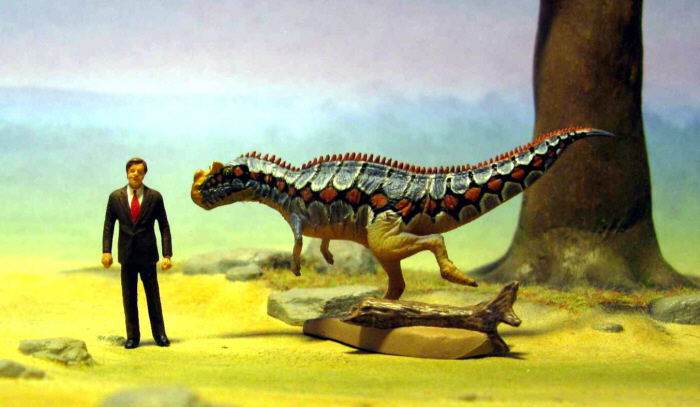
As one of the Kaiyodo Dinotales this figure is tiny and highly accurate at the same time. Measured in a direct line the figure is a mere 86 mm long (95 mm when measured along the curvature where the vertebral centra would have been) and 38 mm high (41 mm including the base). With a head length of approximately 13 mm this results in a scale between 1/48 to 1/58 (extrapolated from skull lengths of 625 and 765 mm taken from literature).
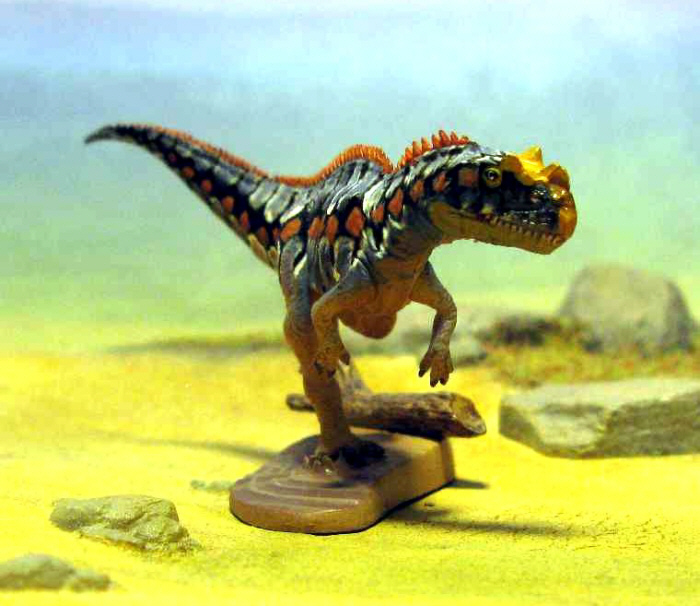
The figure nicely captures the peculiar anatomical characteristics of Ceratosaurus. The head sculpt is close to perfection, boxy, rextangular, laterally compressed and shows correctly shaped nasal and lachrymal horns. The sculpt definitely took the exact skull anatomy into account, even the complete shape of the maxilla is traceable. It is very pleasing to see a theropod figure with closed mouth that doesn’t run around with gaping jaws all day long. The characteristically large teeth alternate in length and are crisply sculpted. They contribute much to the grotesque appearance of Ceratosaurus.
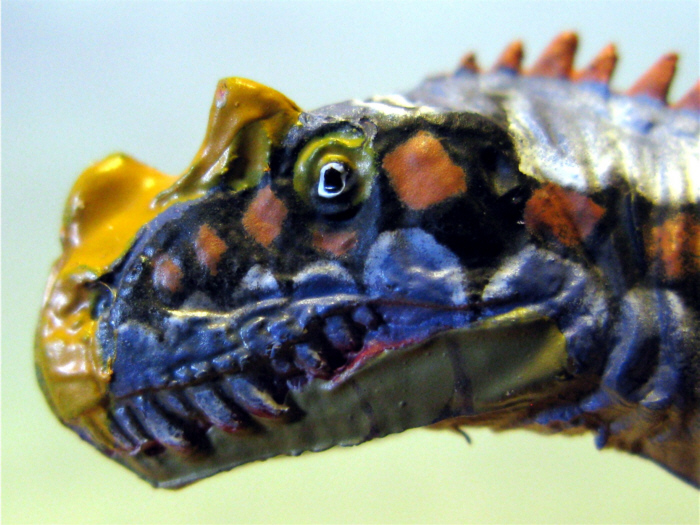
The neck is not held in a strong s-curve and the ribcage is deep but narrow – just like in ceratosaurs in which the ribcages were slimmer than in more advanced theropods. The tail is also very deep, again one of Ceratosaurus‘ trademarks. The mid-dorsal spine row and the four-fingered (albeit pronated) hands are other characteristics that are nicely captured in this figure. The paint work is extremely gaudy but superbly done. Before I saw the figure in person I only knew small photos of it and did not quite like the paint job – but in reality it is very beautifully detailed even for a Dinotales figure. The light greyish blue back and flanks are contrasting with a line of crimson rhomboidal spots embedded in a broad black stripe with white margin. From here, perpendicular black stripes extend upward and downward. All this results in a bizarre, reticulate pattern. The spine row on the back is crimson, the underside is light tan. The forehead including the nasal and lachrymal horns is yellow, suggesting the head ornamentation being used for (even more) display.
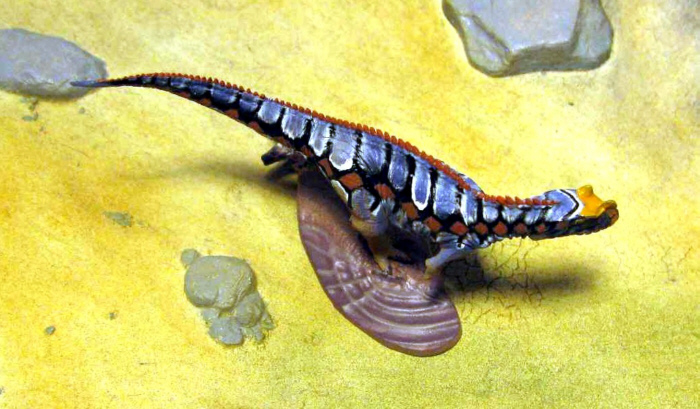
The base deserves a further comment, it is unusually large for a Dinotales figure and the only one that consists of two parts (the tree trunk being an extra part that has to be stuck onto the main base). It is almost like a mini diorama on its own, representing a scene where the Ceratosaurus runs along the shoreline of a pond or lake. It even captures the tremor caused by the running dinosaur resulting in concentric waves.
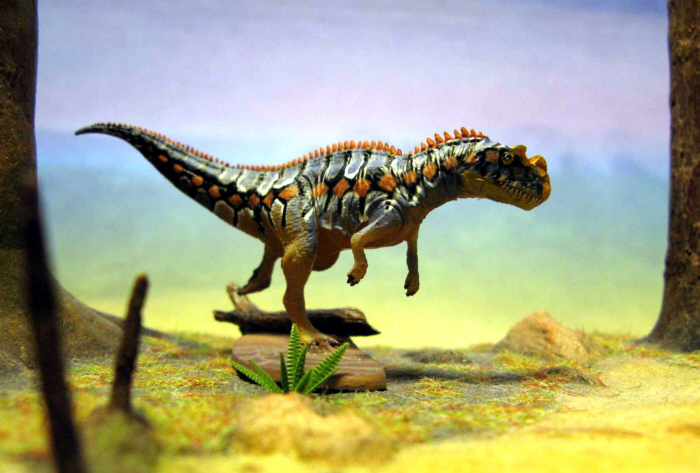
To sum it up: Despite its diminutive size this is a seriously spectacular, mostly anatomically correct figure. Dinotales figures are generally very good but this one stands out in its design. It is highly recommended for every collector – with the only disadvantage being its rarity, so when it is offered it would normally be quite expensive. However, it is one of those figures that really deserves being hunted for. The figure can be found every now and then on eBay here
Disclaimer: links to Ebay and Amazon on the DinoToyBlog are affiliate links, so we make a small commission if you use them. Thanks for supporting us!




[…] may not be 100% correct since Ceratosaurus is often seen as a robust animal as depicted in the Dinotales model. Other issues include pronation of both hands and the absence of signature armour on the […]
I have a blog. There is a customized ceratosaurs. http://ceratosaurus.blogspot.com/
Thanks for the link, Marc. I just looked at the figures. I see now that Allosaurus had a slightly semilunate carpal but the degree of adduction is very limited. The maximum adduction shown in the figure (7 D) is far less than what the Dinotales 6 Allosaurus shows – its wrists are bent like in an advanced maniraptoran, something like 45 degrees or more. Still I consider both the Allosaurus and the Ceratosaurus excellent figures.
Real nice. Now we need a good Ceratosaurus from a museum line!
Allosaurus did have a semilunate carpal of sorts according to Kenneth Carpenter: “Allosaurus has a ‘semilunate’ carpal…formed by distal carpal 1.” (Full PDF of his paper available here http://www.springerlink.com/content/14662n72u5791373/)
Thanks for the comments, I agree that the splayed arms would affect the orientation of the palms. But I don’t think that they are splayed to that extent that the palms should completely face backwards. The position of the arms is very similar to that of Series 3 Acrocanthosaurus and Series 5 Tyrannosaurus where the palms face each other more than in this figure. I’ve seen other peculiarities in Dinotales arms, the Series 6 Allosaurus has its hands bent as if it had a semilunate carpal. And Griffin, there is some trace of whitish paint on the teeth of the head’s left side but it may have been too feebly applied in this specimen.
I agree with Griff that the arms look to be splayed, which would explain the backward-facing palms. It’s rare that a Dinotales figure gets such things wrong.
Lovely figure. It looks like the teeth on only one side of the head are actually painted though. The wrists I think are actually correct since they are being bent at the shoulder. If you imagine them being angled back against the body the palms would be facing each other as they should.
Gorgeous shots.